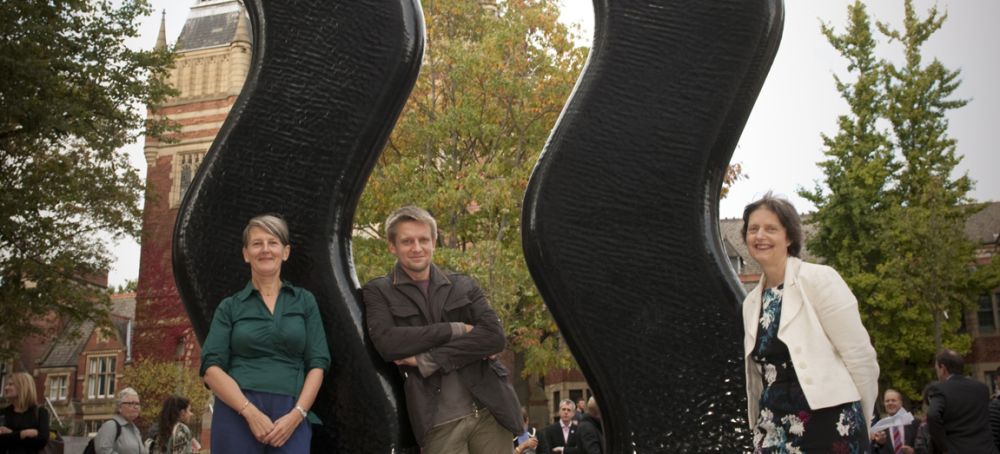
A major new piece of art was unveiled today as part of a significant refurbishment project at the University of Leeds.
Tate Britain Director Penelope Curtis revealed the monumental new work – Sign for Art (Stelae 2014), by Yorkshire-based artist Keith Wilson – in the newly-reopened Beech Grove Plaza, close to the heart of the campus.
The redevelopment of the area, which has included significant refurbishment of the nearby Social Sciences Building, provides staff, students and visitors with a bright, open gateway on to campus.
The 5.1 metre (16ft 8ins) sculpture is made of Keith Wilson’s signature black polyurethane elastomer, which gives its surface a dramatic, rippled effect.
Professor Wilson said: “Immediately after leaving the Slade in the late 1980s, I worked for a year with deaf-blind adults as an art instructor. Drawing two spaced fingertips in a wave motion across the forehead of the student – a tactile ‘brainwave’ sign – announced the arrival of the artist, the subject of art, and the imminent activity of making art.
“This modification of the British Sign Language sign, presumably derived from the making of a brushstroke, struck home, and stayed with me.
“Sign for Art is just that. In the face of the proverbial ‘What does it mean?’ this sculpture, at the very least, has an answer.”
Dr Curtis said: "Keith Wilson is a very singular artist whose work always has both a mischievous and a serious side. His forms follow their material, and in this case the stele references not only the grave markers of the classical world, but also the upright markers of post-war minimalism."
As well as Sign for Art and new seating and lighting, the plaza also incorporates planting aimed at attracting a more diverse range of wildlife to the area.
In line with the University Biodiversity Action Plan, this includes indigenous species such as small-leaved lime trees, a native “green wall” and a variety of herbs and grasses that will encourage pollinating insects and birds to the area.
Dennis Hopper, the University’s Director of Facilities Management, has taken a keen interest in public art on Leeds’ campus.
He said: “The proximity of the artwork and plaza to the refurbished Social Sciences building means this area of campus is now much more welcoming and accessible, providing a space where people can meet, relax or simply pass through and enjoy.”
The University is currently finalising a new Public Art Strategy, an ambitious programme focusing on public art that spans a wide range of the University’s activities, including research, student experience, communications, fundraising, audience development and building partnerships locally, nationally and internationally.
* Stelae are standing stone slabs used in the ancient world primarily as grave markers but also for dedication, commemoration, and demarcation.
Pictured are, from left, Penelope Curtis, Keith Wilson and Stella Butler, University Librarian.
Further information
- Following the formal unveiling at 2pm, a talk on “Sculpture Outdoors” was given by Dr Curtis and Mr Wilson in the University’s Centenary Gallery.
- Keith Wilson studied at The Ruskin School of Art in Oxford and London’s Slade School of Fine Art. He completed a major commission for Queen Elizabeth Olympic Park in time for the 2012 Olympic and Paralympic Games. In 2011, he jointly curated – with Dr Curtis – Modern British Sculpture at the Royal Academy. He is Professor of Sculpture at Sheffield Hallam University and lives and works in Sheffield and London.
- Penelope Curtis became Director of Tate Britain in 2010, joining from the Henry Moore Institute in Leeds, where she was curator from 1994. She has chaired the Turner Prize judging panel for the past four years and written widely on 20th century British sculpture, European art and architecture of the inter-war years and on many contemporary sculptors. For more details, see www.tate.org.uk/about/who-we-are/tate-structure-and-staff/tate-britain.
- For further details, or to arrange interviews with the artist, contact Gareth Dant, Press Officer, on 0113 3433996 or email g.j.dant@leeds.ac.uk.